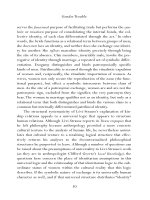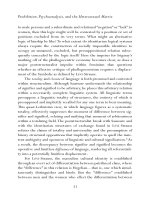GENDER TROUBLE 130
Bạn đang xem bản rút gọn của tài liệu. Xem và tải ngay bản đầy đủ của tài liệu tại đây (20.3 KB, 1 trang )
Prohibition, Psychoanalysis, and the Heterosexual Matrix
“before” takes place within the terms of the “after” and, hence, becomes
an attenuation of the law itself into the site of its absence.
Although Rubin claims that the unlimited universe of sexual possibilities exists for the pre-Oedipal child, she does not subscribe to a
primary bisexuality. Indeed, bisexuality is the consequence of childrearing practices in which parents of both sexes are present and
presently occupied with child care and in which the repudiation of
femininity no longer serves as a precondition of gender identity for
both men and women (199).When Rubin calls for a “revolution in kinship,” she envisions the eradication of the exchange of women, the
traces of which are evident not only in the contemporary institutionalization of heterosexuality, but in the residual psychic norms (the institutionalization of the psyche) which sanction and construct sexuality
and gender identity in heterosexual terms. With the loosening of the
compulsory character of heterosexuality and the simultaneous emergence of bisexual and homosexual cultural possibilities for behavior
and identity, Rubin envisions the overthrow of gender itself (204).
Inasmuch as gender is the cultural transformation of a biological polysexuality into a culturally mandated heterosexuality and inasmuch as
that heterosexuality deploys discrete and hierarchized gender identities
to accomplish its aim, then the breakdown of the compulsory character
of heterosexuality would imply, for Rubin, the corollary breakdown of
gender itself. Whether or not gender can be fully eradicated and in
what sense its “breakdown” is culturally imaginable remain intriguing
but unclarified implications of her analysis.
Rubin’s argument rests on the possibility that the law can be effectively overthrown and that the cultural interpretation of differently
sexed bodies can proceed, ideally, without reference to gender disparity. That systems of compulsory heterosexuality may alter, and indeed
have changed, and that the exchange of women, in whatever residual
form, need not always determine heterosexual exchange, seems clear;
in this sense, Rubin recognizes the misogynist implications of Lévi-
95









